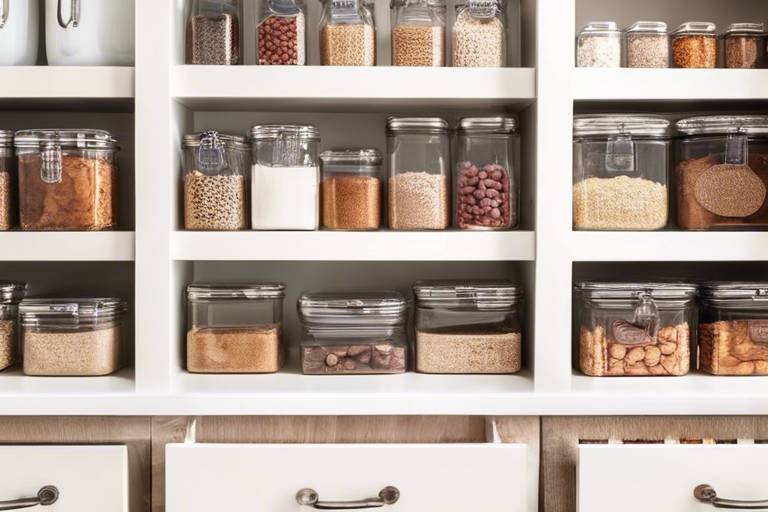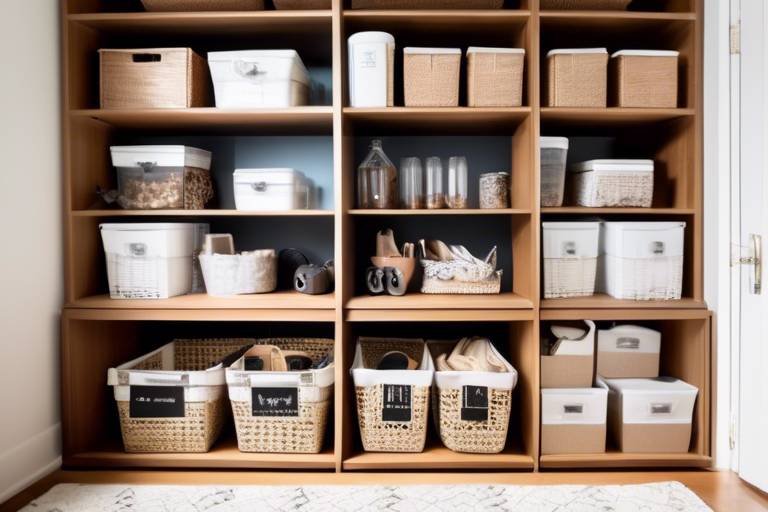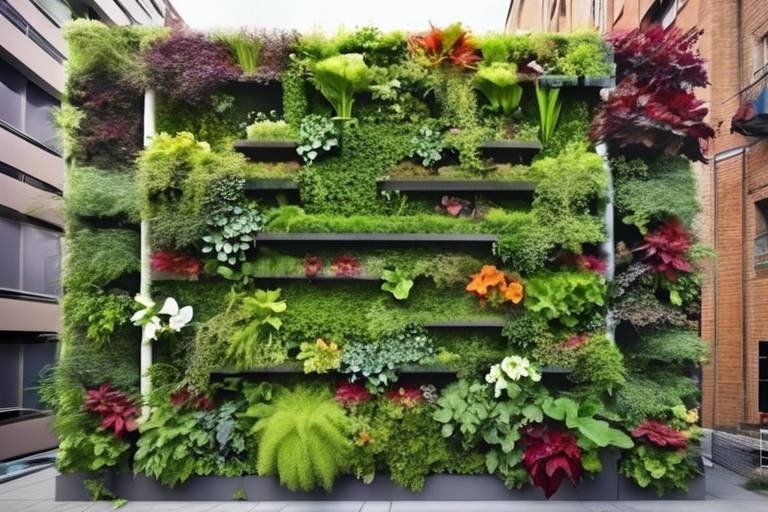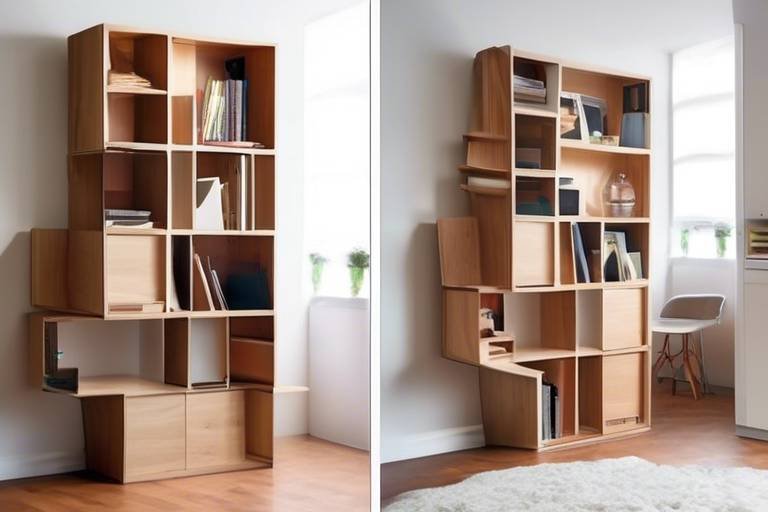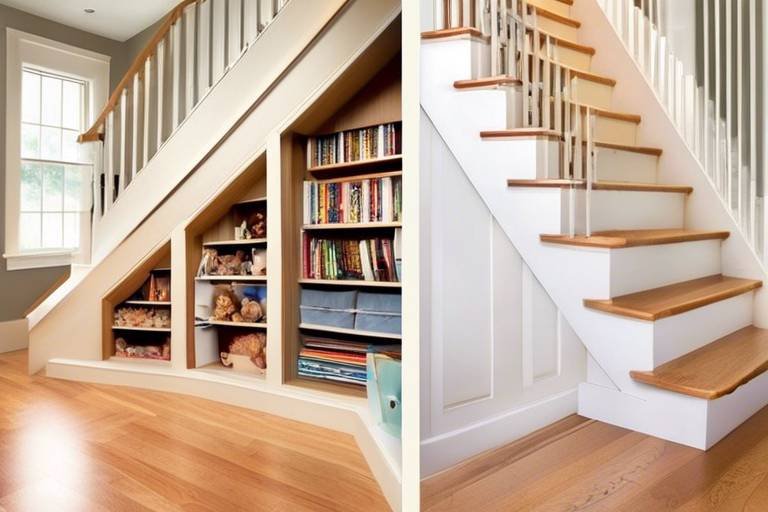Creative Ideas for Organizing a Small Home’s Pantry
Discover innovative ways to maximize space and efficiency in a compact pantry. From storage solutions to labeling tips, these creative ideas will help you declutter and organize your small home's pantry effectively.
When it comes to organizing a small home's pantry, utilizing door space efficiently can make a significant difference. By installing racks, hooks, or baskets on the back of the pantry door, you can store spices, small jars, or utensils, freeing up valuable shelf space inside the pantry.
Investing in clear containers is another smart move. Opt for transparent containers to store dry goods like pasta, rice, and snacks. Not only do they keep your pantry organized, but they also make it easy to see when supplies are running low.
Labeling everything in your pantry is essential for quick access and maintaining order. Consider using chalkboard labels or a label maker to label shelves, containers, and baskets for a neat and uniform look.
Maximizing vertical space is key in a small pantry. Install shelves from floor to ceiling to store more items while keeping them easily accessible and visible. This simple trick can create a significant impact on your pantry organization.
Creating zones within your pantry based on food categories can streamline your organization process. By categorizing items such as snacks, baking supplies, and canned goods, you can easily find what you need and maintain a well-organized pantry.
Consider installing pull-out shelves or drawers in your pantry to make reaching items at the back easier. This solution maximizes space and ensures nothing gets lost in the depths of your shelves, making your pantry more functional.
Utilizing baskets and bins to group similar items together is a practical approach. Whether it's storing baking ingredients or snacks, using pull-out baskets can help keep your pantry organized and efficient.
To prevent food items from expiring, it's crucial to rotate stock regularly following the first in, first out rule. Check expiration dates frequently and move older items to the front to avoid any wastage in your well-organized pantry.
Don't overlook unused spaces in your pantry. Utilize unconventional areas like the top of your pantry or the sides of shelves by installing hooks, racks, or mini shelves to store items like paper towels, aprons, or small appliances efficiently.

Utilize Door Space Efficiently
Discover innovative ways to maximize space and efficiency in a compact pantry. From storage solutions to labeling tips, these creative ideas will help you declutter and organize your small home's pantry effectively.
When it comes to optimizing a small pantry, every inch counts. One often overlooked area is the back of the pantry door. By utilizing this space effectively, you can free up valuable shelf space inside the pantry. Consider installing racks, hooks, or baskets on the door to store spices, small jars, or utensils. This not only maximizes storage capacity but also ensures easy access to frequently used items without cluttering the shelves.
Additionally, you can create a simple and efficient storage system by using an over-the-door organizer with pockets or compartments. This allows you to neatly store small items like packets, condiments, or even kitchen tools, making the most of the vertical space.
If you prefer a more DIY approach, installing a pegboard on the pantry door can provide a customizable solution for hanging various items. Pegboards offer versatility in organizing different sizes of containers, tools, or accessories, giving you the freedom to design the space according to your needs.
By making the most of the door space in your pantry, you can enhance accessibility, visibility, and overall organization, creating a functional and efficient storage area even in the smallest of spaces.

Invest in Clear Containers
Discover innovative ways to maximize space and efficiency in a compact pantry. From storage solutions to labeling tips, these creative ideas will help you declutter and organize your small home's pantry effectively.
Make use of the back of the pantry door by installing racks, hooks, or baskets to store spices, small jars, or utensils, freeing up valuable shelf space inside the pantry.
Opt for transparent containers to store dry goods like pasta, rice, and snacks. Not only do they keep your pantry organized, but they also make it easy to see when supplies are running low.
Labeling shelves, containers, and baskets can help you quickly locate items and maintain a tidy pantry. Consider using chalkboard labels or a label maker for a neat and uniform look.
Maximize vertical space by installing shelves from floor to ceiling. This allows you to store more items while keeping them easily accessible and visible.
Divide your pantry into zones based on food categories such as snacks, baking supplies, and canned goods. This organizational system makes it simpler to find what you need and maintain order.
Consider installing pull-out shelves or drawers in your pantry to make reaching items at the back easier. This solution maximizes space and ensures nothing gets lost in the depths of your shelves.
Use baskets and bins to group similar items together, such as baking ingredients or snacks. Pull-out baskets can be particularly useful for storing potatoes, onions, or other produce.
To prevent food items from expiring, practice the first in, first out rule. Regularly check expiration dates and move older items to the front, ensuring nothing goes to waste in your well-organized pantry.
Don't overlook unconventional spaces like the top of your pantry or the sides of shelves. Install hooks, racks, or mini shelves to store items like paper towels, aprons, or small appliances.
When it comes to organizing a small pantry effectively, investing in clear containers can be a game-changer. These transparent containers not only keep your pantry looking neat and organized but also offer practical benefits. By using clear containers to store dry goods such as pasta, rice, and snacks, you can easily see the contents at a glance, making it simple to track when supplies are running low and what needs restocking. Additionally, clear containers create a cohesive and visually appealing look in your pantry, enhancing the overall organization and efficiency of the space.
Q: How often should I rotate the stock in my pantry?
A: It is recommended to check and rotate your pantry stock every 3-6 months to ensure that items are used before they expire.
Q: Can I use baskets and bins for organizing non-food items in the pantry?
A: Yes, baskets and bins can be versatile storage solutions for organizing non-food items like kitchen linens, small appliances, or cleaning supplies in your pantry.
Q: What is the benefit of creating zones in the pantry?
A: Creating zones in your pantry helps to categorize items, making it easier to locate what you need and maintain a systematic organization that saves time and reduces clutter.

Label Everything
When it comes to organizing a small home's pantry, one of the most crucial steps is to properly. This simple yet effective practice can make a significant difference in how efficiently you can locate items and maintain order in your pantry. By clearly labeling shelves, containers, and baskets, you not only create a visually appealing pantry but also streamline your cooking and meal preparation process.
Consider using chalkboard labels that can be easily erased and rewritten as needed, giving your pantry a versatile and customizable look. Alternatively, a label maker can provide a more uniform and professional appearance to your storage containers and shelves. With labels in place, you can quickly identify where each item belongs and ensure that everything has its designated spot.
Furthermore, organizing your pantry with labeled zones can enhance your overall efficiency. By categorizing items into specific sections such as snacks, baking supplies, or canned goods, you create a systematic approach to finding what you need. This division not only helps in maintaining a tidy pantry but also saves you time during meal preparation as you know exactly where to look for specific ingredients.
For a more cohesive and visually appealing pantry, consider color-coding your labels to correspond with different food categories. This visual cue can further streamline the organization process and make it easier for everyone in the household to follow the system. Additionally, incorporating labels with expiration dates can help you keep track of food items that need to be consumed sooner, reducing food waste and ensuring freshness.

Use Vertical Space
When it comes to organizing a small home's pantry, utilizing vertical space is key to maximizing storage capacity. By installing shelves that reach from floor to ceiling, you can effectively make use of every inch of available space. This not only allows you to store more items but also keeps everything easily accessible and visible at a glance.
Imagine your pantry as a skyscraper, with each shelf representing a different floor. Just like in a building, the higher you go, the more space you have to store your belongings. By going vertical, you can create a well-organized system where each item has its designated place, making it effortless to locate what you need without rummaging through cluttered shelves.
Additionally, vertical shelving provides a visually appealing display of your pantry items. Picture a library with books neatly stacked from bottom to top, creating a sense of order and efficiency. Similarly, organizing your pantry vertically not only saves space but also adds a touch of elegance to your kitchen storage.
If you find yourself struggling with limited horizontal space in your pantry, look up and consider the untapped potential of vertical storage. By thinking vertically, you can revolutionize the way you organize your small home's pantry, turning it into a functional and aesthetically pleasing space.

Create Zones
When it comes to organizing a small home's pantry, creating zones based on food categories can be a game-changer. Imagine your pantry as a well-organized grocery store, with each section dedicated to specific items like snacks, baking supplies, or canned goods. By categorizing your pantry in this way, you not only make it easier to find what you need quickly but also maintain order effortlessly.
Picture a pantry where all your baking essentials are neatly grouped together in one area, making it a breeze to locate flour, sugar, and baking powder when you're whipping up a batch of cookies. With designated zones, you can say goodbye to rummaging through shelves in search of that elusive ingredient and hello to a more streamlined and efficient cooking experience.
Moreover, organizing your pantry into zones can help you keep track of inventory more effectively. By knowing exactly where each type of item belongs, you can easily spot when supplies are running low and make timely grocery trips without the risk of forgetting essential items. This proactive approach to pantry organization not only saves you time but also reduces the chances of food waste.
To further enhance the zoning system in your pantry, consider using labels or color-coding to differentiate between different categories. This visual cue can aid in quick identification and ensure that every family member knows where items belong when it's time to restock or tidy up. By implementing a zoning strategy in your small home's pantry, you can transform a cluttered storage space into a well-structured and efficient area that simplifies your daily meal preparation.

Install Pull-Out Shelves
When it comes to optimizing space in a small pantry, installing pull-out shelves can be a game-changer. These shelves are designed to slide out, allowing you easy access to items stored at the back without having to rummage through everything in front. Imagine effortlessly reaching for that jar of spices or bag of flour without having to empty half the pantry first. Pull-out shelves not only maximize storage capacity but also ensure that every inch of space is utilized effectively.

Utilize Baskets and Bins
When it comes to organizing a small home's pantry, utilizing baskets and bins can be a game-changer. These storage solutions not only help in decluttering your pantry but also add a touch of organization and efficiency to the space. By grouping similar items together in baskets and bins, you can easily locate what you need without rummaging through shelves aimlessly.
Imagine having all your baking ingredients neatly stored in one basket, or your favorite snacks conveniently placed in a labeled bin. This not only saves you time but also gives your pantry a visually appealing and cohesive look. Pull-out baskets can be particularly handy for storing items like potatoes, onions, or other produce that need proper ventilation and easy access.
Additionally, utilizing baskets and bins can help in maximizing space by making use of vertical storage. Placing smaller items in baskets and stacking them on shelves can free up valuable shelf space for larger items or appliances. It's like creating a mini storage system within your pantry, where everything has its designated place.

Rotate Stock Regularly
When it comes to maintaining an organized pantry, one crucial step is to . This practice involves following the first in, first out rule to ensure that your food items are used before they expire. By regularly checking expiration dates and moving older items to the front, you can prevent wastage and keep your pantry well-organized.

first in, first out
Discover innovative ways to maximize space and efficiency in a compact pantry. From storage solutions to labeling tips, these creative ideas will help you declutter and organize your small home's pantry effectively.
Make use of the back of the pantry door by installing racks, hooks, or baskets to store spices, small jars, or utensils, freeing up valuable shelf space inside the pantry.
Opt for transparent containers to store dry goods like pasta, rice, and snacks. Not only do they keep your pantry organized, but they also make it easy to see when supplies are running low.
Labeling shelves, containers, and baskets can help you quickly locate items and maintain a tidy pantry. Consider using chalkboard labels or a label maker for a neat and uniform look.
Maximize vertical space by installing shelves from floor to ceiling. This allows you to store more items while keeping them easily accessible and visible.
Divide your pantry into zones based on food categories such as snacks, baking supplies, and canned goods. This organizational system makes it simpler to find what you need and maintain order.
Consider installing pull-out shelves or drawers in your pantry to make reaching items at the back easier. This solution maximizes space and ensures nothing gets lost in the depths of your shelves.
Use baskets and bins to group similar items together, such as baking ingredients or snacks. Pull-out baskets can be particularly useful for storing potatoes, onions, or other produce.
To prevent food items from expiring, practice the rule. Regularly check expiration dates and move older items to the front, ensuring nothing goes to waste in your well-organized pantry.
Don't overlook unconventional spaces like the top of your pantry or the sides of shelves. Install hooks, racks, or mini shelves to store items like paper towels, aprons, or small appliances.
Feel free to browse through these commonly asked questions:
- Q: How often should I organize my pantry?
- A: It is recommended to organize your pantry every 3-6 months to ensure everything is in order and to prevent expired items.
- Q: What is the benefit of using clear containers?
- A: Clear containers allow you to see the contents easily, helping you keep track of your pantry supplies and avoid overstocking.

rule. Regularly check expiration dates and move older items to the front, ensuring nothing goes to waste in your well-organized pantry.
Discover innovative ways to maximize space and efficiency in a compact pantry. From storage solutions to labeling tips, these creative ideas will help you declutter and organize your small home's pantry effectively.
Make use of the back of the pantry door by installing racks, hooks, or baskets to store spices, small jars, or utensils, freeing up valuable shelf space inside the pantry.
Opt for transparent containers to store dry goods like pasta, rice, and snacks. Not only do they keep your pantry organized, but they also make it easy to see when supplies are running low.
Labeling shelves, containers, and baskets can help you quickly locate items and maintain a tidy pantry. Consider using chalkboard labels or a label maker for a neat and uniform look.
Maximize vertical space by installing shelves from floor to ceiling. This allows you to store more items while keeping them easily accessible and visible.
Divide your pantry into zones based on food categories such as snacks, baking supplies, and canned goods. This organizational system makes it simpler to find what you need and maintain order.
Consider installing pull-out shelves or drawers in your pantry to make reaching items at the back easier. This solution maximizes space and ensures nothing gets lost in the depths of your shelves.
Use baskets and bins to group similar items together, such as baking ingredients or snacks. Pull-out baskets can be particularly useful for storing potatoes, onions, or other produce.
To prevent food items from expiring, practice the first in, first out rule. Regularly check expiration dates and move older items to the front, ensuring nothing goes to waste in your well-organized pantry.
Don't overlook unconventional spaces like the top of your pantry or the sides of shelves. Install hooks, racks, or mini shelves to store items like paper towels, aprons, or small appliances.

Make Use of Unused Spaces
When it comes to organizing a small home's pantry, it's essential to make the most of every available space, including the often overlooked unused areas. These spaces, such as the top of your pantry or the sides of shelves, can be transformed into valuable storage areas with a little creativity and the right organizational tools.
One effective way to utilize unused spaces is by installing hooks or racks on the inside of pantry doors. This can provide a convenient spot to hang aprons, kitchen towels, or even small lightweight appliances, keeping them off the countertops and within easy reach when needed.
Another clever solution is to add mini shelves to the sides of existing shelves. These additional surfaces can be used to store smaller items like spices, condiments, or recipe books, creating more storage capacity without taking up extra floor space.
If you have a tall pantry with high shelves, consider using a step stool to access the top shelves more easily. This often underutilized area can be ideal for storing infrequently used items or bulky kitchen appliances that you don't need to access regularly.
Additionally, don't forget about the space above your pantry cabinets. This area can be perfect for storing items that are not used daily, such as large serving platters, seasonal kitchenware, or extra pantry supplies bought in bulk. Utilizing this overhead space can help free up valuable room inside the pantry for everyday essentials.
By thinking outside the box and exploring these unused spaces in your small home's pantry, you can maximize storage efficiency and create a well-organized space that meets your needs.
Frequently Asked Questions
- How can I make the most of a small pantry space?
Utilize door space efficiently by installing racks or hooks, invest in clear containers for easy visibility, use vertical space with floor-to-ceiling shelves, create zones for different food categories, and install pull-out shelves for better access.
- Why is labeling important in pantry organization?
Labeling shelves, containers, and baskets helps in quickly finding items and maintaining a tidy pantry. It also ensures items are stored in designated places, making it easier to keep track of inventory.
- How do I prevent food items from expiring in a well-organized pantry?
Regularly rotate stock following the first in, first out rule to use older items first. Check expiration dates, move older items to the front, and keep track of what needs to be consumed sooner to minimize food waste.


